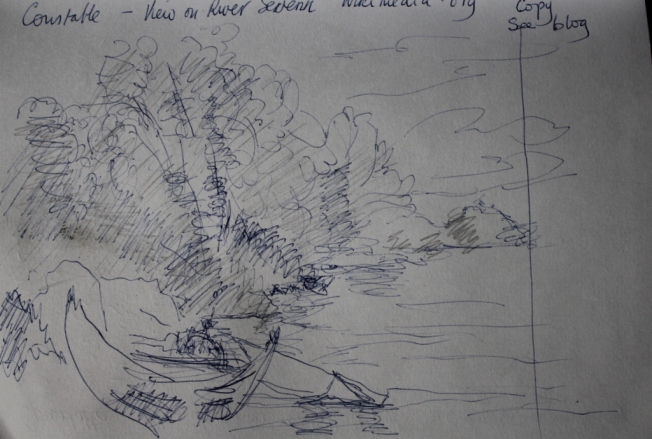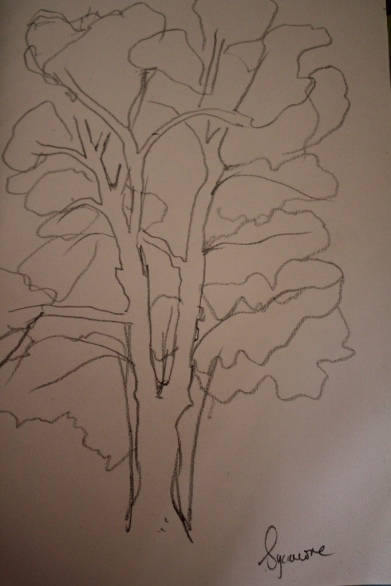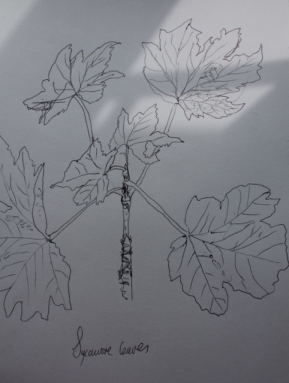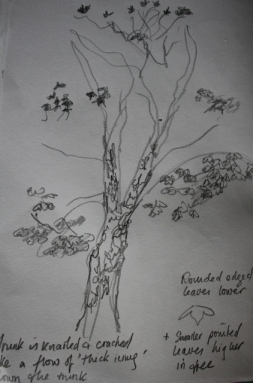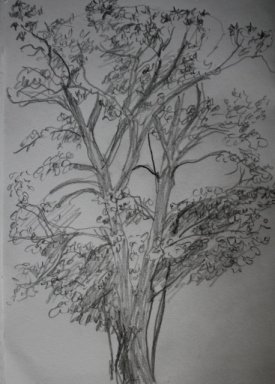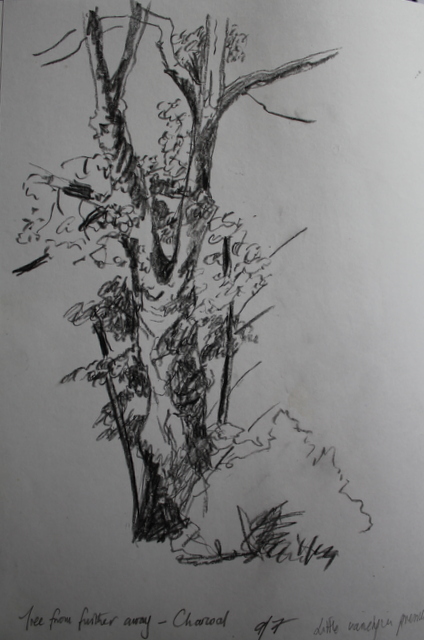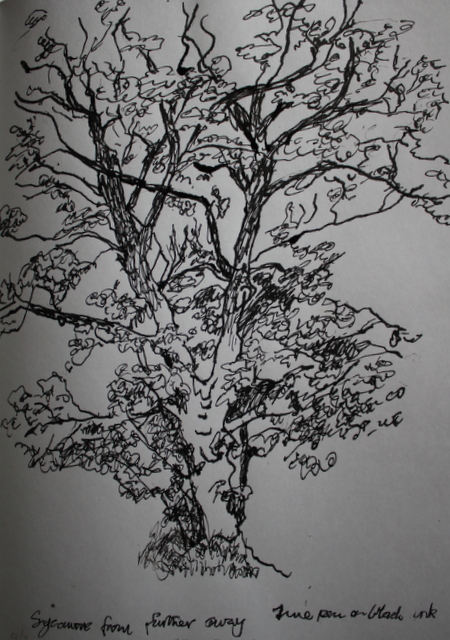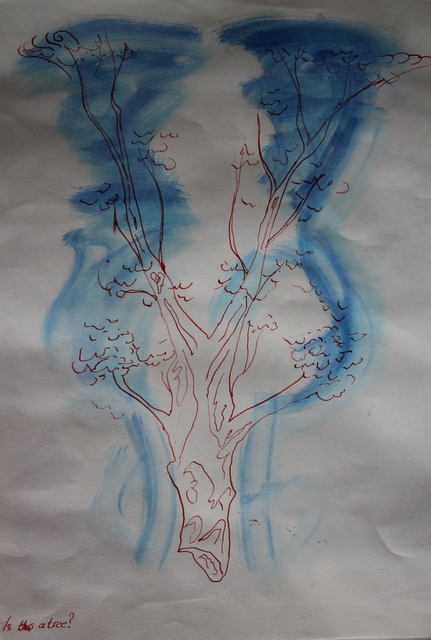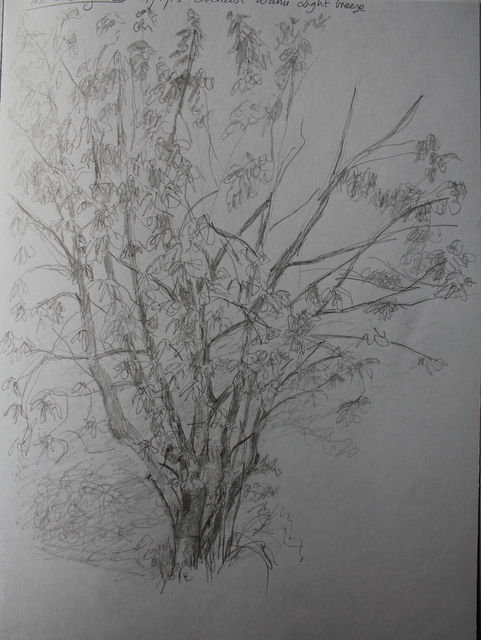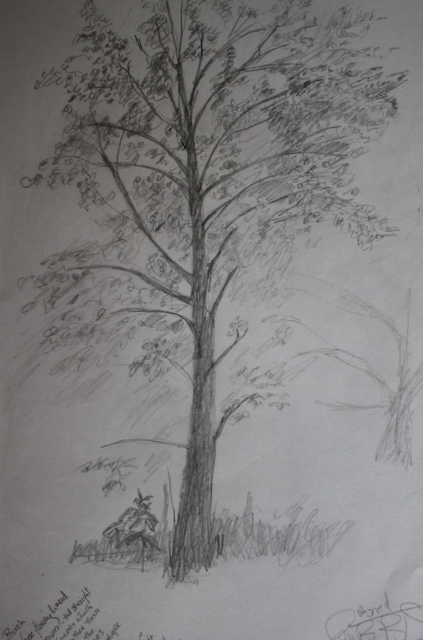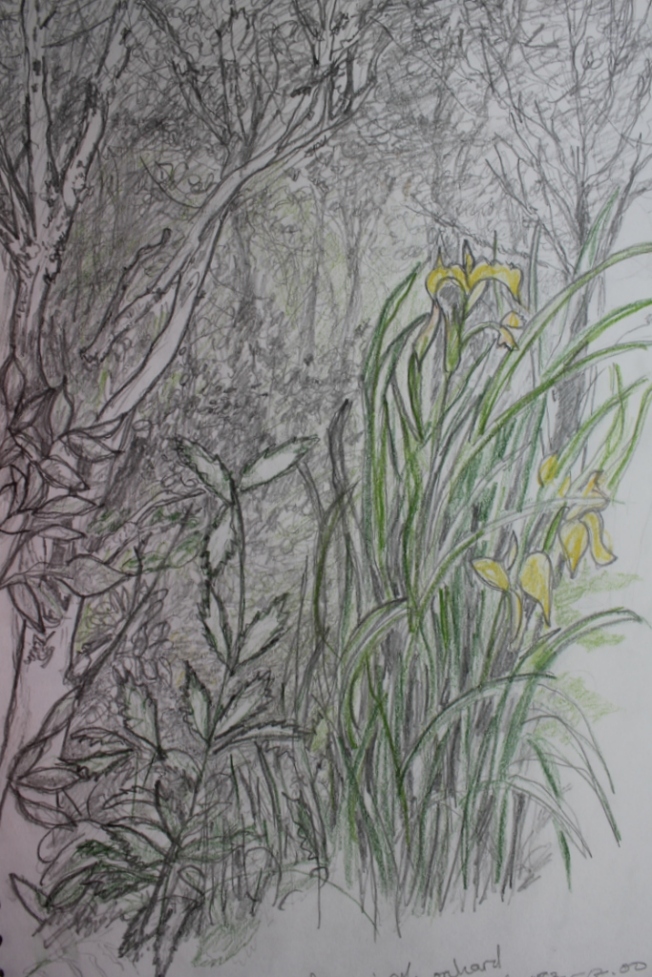1) Sketching an individual tree
How can I use the drawings in the two books “Vitamin D ” and “Drawing Now” to inspire me in drawing trees? A tree is to be a figurative drawing is it not? an exercise in observation and the use of certain materials? and yet the images in these books have been abstracted and distrorted by thoughts and feelings.
The thoughts that come to mind are the relationship between the branches of the tree and the blood vessels or bronchi, the destruction of the tree by man’s need to produce fields and factories, the tree as a life that stands well beyond our measued years, a tree as history, and yet does not move from the same spot or communicate (a tree cannot produce art), it has sensory systems which detect light and water and food, what are its motor systems? its means of changing itself or its world around? It slowly permeates as it grows in response to the nutrients it gains by the action of its sensory systems, it loses its leaves as direct reflex to cold and lack of light–is this art? sensation producing output but without the control or manipulation of a higher centre-no will. Art needs the higher centres.
Let us resort to more old fashioned depictiond of trees- drawn for the love of the tree -and Constable’s drawings of trees:
Looking at Constable’s drawings of trees:
John Constable – View on the River Severn at Worcester
sourced on line (July 2013) from:http://commons.wikimedia.org/wiki/File:John_Constable_-_View_on_the_River_Severn_at_Worcester_-_WGA5205.jpg
I copied this drawing in pencil and biro -merely as a means of following the manner in which Constable had dealt with the trees, which were representated by areas of hatching in several directions mainly diagonally and horizontally and varied in the intensity of pressure and the size of the line. I’m not sure of the nature of his drawing implement, but mush softer than biro and hard pencil.
Elm trees in Old Hall Park, East Bergholt, 1817
John Constable
sourced on line (July 2013) from: http://www.john-constable.org/Elm-trees-in-Old-Hall-Park,-East-Bergholt,-1817.html
I enlarged an area of this tree to try to work out how Constable had approached the drawing-see below–It wasn’t obvious if he had used cross hatching in the tree -although there were some very light areas which could have been cross hatched. It wasn’t clear what implement he used although I trust it was a soft fine tipped pencil to account for the degree of detail. I used a conte crayon which was too thick and it proved very difficult to maintain concentration for the amount of work in the foliage.
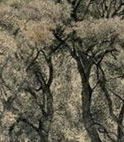 sourced on line (July 2013) and cropped to show area that I attempted to copy : sourced on line (July 2013) from: http://www.john-constable.org/Elm-trees-in-Old-Hall-Park,-East-Bergholt,-1817.html
sourced on line (July 2013) and cropped to show area that I attempted to copy : sourced on line (July 2013) from: http://www.john-constable.org/Elm-trees-in-Old-Hall-Park,-East-Bergholt,-1817.html
Frederic Lord Leighton (British,1830-1896) Study of a Lemon Tree 1859 Pencil on paper sourced on line (July 2013 from http://www.artrenewal.org/pages/artwork.php?artworkid=9617&size=large
and what of this beautiful delicate and intricately observed Lemon tree by Frederick Lord Leighton , each leaf represented in full either in strong or fine line,areas between the leaves “filled in” with lines of twigs and branches, no cross hatching but soft block shading with light falling on the branches. The tree is beautiful in its delicacy and able to stand alone as in the representation by its very quiet presence.
My drawings of trees
I love leaves that produce a lace-like and fine effect as in the drawing by Lord Leighton above. Why is lace attractive? Why am I drawn to the fine lines and small areas of light against dark, the softness, the feel of light breeze through the leaves as the sun filters to the ground. The small shadows which move with the swaying, rustling play of the leaves. The sun filtering through and dappling the shadows with light.
2) Texture of the foliage
The sycamore is a tall branching solid tree with a knarled bark, appearing as though layers have been poured one on the other, the branches are long and irregular in shape ending in twisted small twigs. The leaves grow from all terminal branches, originating opposite each other, they are flat almost hand shaped having five lobes and sway in the wind in a more composite manner than the feathery smaller leaves of the taller thinner birch or silver birch. The sycamore is solid and knarled, the old man of the garden.
These rough sketches were followed by more studies in different media, whereby I drew the tree from an ever increasing distance:
1) the trunk
I like this more detailed image of the trunk. The light altered as I drew and the daplled areas moved. The pencil became blunt-a recurring problem!
The trunk and prime branches
3) the tree in pen and ink:
This has captured the knarled feel of the sycamore. By virtue of its low and heavy branches and thick foliage, it appears short and squat despite being one of the tallest trees.
I then went back to Vitamin D drawing book (Vitamin D New Perspectives in Drawing Phaidon Press ISBN 978 0 7148 4545 6) and was looking at the work of Sandra Cinto (pg 062-063) who produces fairy tale images in ink and acrylic on mdf :
image sourced on line (July 2013) from : http://www.artnet.com/artwork/426265824/424453332/sandra-cinto-untitled.html
|
|||
|
|||
|
|||
|
|||
|
This image could relate to the annual rings of a tree trunk as well as water or even the microscopic appearance of bark in its rising and falling layers.
Photographic image of page 063 from (Vitamin D New Perspectives in Drawing Phaidon Press ISBN 978 0 7148 4545 6) both images named :Untitled 2000(ink and acrylic on mdf) Untitled 2000 (ink and acrylic on mdf)by Sandra Cinto
-I’m not sure which part of the image is ink and which acrylic, although I imagine the black background is ink and the white images are in acrylic. I wanted to reproduce the little star like formations to represent the leaves of the sycamore tree with which I was involved –I chose to draw in black crayon which is far too “thick ” and clumsy to approach anything similar to Sandra Cionto’s images of delicate tiny star like formations -in the end my result was a drawing of a tree in negative:
I think it could be worked upon using different media to produce a similar feel to the pictures above done by Sandra Cinto but perhaps the sycamore being solid and knarled is not the best subject.
I also revisited the conceptual ideas of the meaning of tree which I had played with at the beginning of the exercise and redrew the tree in red ink in a manner that could fit with my knowledge of anatomy:
This particular image was provoked by looking at the images of Kaoru Arima (ref: (Vitamin D New Perspectives in Drawing Phaidon Press ISBN 978 0 7148 4545 6) who draws “fragile line” drawings with deeper meanings. The drawing above represented the descending aorta with its ramifications –a pathology book helped to depict atheroma (which is the narrowing of the artery by the hard bark like lines in its inside —is this a too blatant a connection between thought and art?
Other individual trees:
The Hawthorn in pencil and Beech in conte crayon:
The hawthorn is one of my favourite trees -small very twisted and knarled and prickly and not really going anywhere and with beautiful flowers in Spring –this image does not do it justice, partly because of the choice of tree.
The beech, tall and thin with a smooth bark with foliage (in this particular tree) only in its upper quarter is not well drawn in the thick conte crayon and gives no feel of its tall aloofness and dancing leaves which remind me of a slender ballet dancer.
The cherry tree in fine soft pencil
The Hazel tree: It was so hot drawing this tree that although there was a feint breeze rippling the feathery leaves I had to abandon. The notes on the image read: fast free flowing hand. Distinctiveness -tall and straight small leaves which “jiggle” rather than “wave ” like the sycamore’s leaves. Conical in shape. Very hot sun almost directly above 13:00hrs 13/7. Bored and “Rubbish”-demark the lower left edge. (It was too hot and I couldn’t see the foliage through the beads of sweat).
STUDY OF SEVERAL TREES
Moving to the cooler environment of the orchard where I sat amongst the nettles:
“Sitting in the orchard” this drawing took 1.5 hours and was done in the shade with light catching areas in the near and mid ground. It was started at 15:30 hrs. I love the drawing, the dominant foreground, the confusion of the mid and background and the hint of colour in the form of coloured pencils.
and then to “the young woodland” This was drawn in brown ink with a fine nib pen and areas of colour were added with oil pastels :It was again very hot and in direct sunlight. I love the confusion of lines and marks as the grasses give way to the small trees in the background. Small oaks frame the image and the purple of the thistles catch the eye in the mid and fore ground, otherwise there are no points of interest and I like that sensation. I didn’t originally like the colours-whilst I was sitting drawing the oil pastels were melting and not easy to handle and the colours were not to my liking but I think it holds well together and am quite pleased with the image.
This was drawn in brown ink with a fine nib pen and areas of colour were added with oil pastels :It was again very hot and in direct sunlight. I love the confusion of lines and marks as the grasses give way to the small trees in the background. Small oaks frame the image and the purple of the thistles catch the eye in the mid and fore ground, otherwise there are no points of interest and I like that sensation. I didn’t originally like the colours-whilst I was sitting drawing the oil pastels were melting and not easy to handle and the colours were not to my liking but I think it holds well together and am quite pleased with the image.
Having left the subject of trees I was “surfing” the Cork street galleries in London and discovered : Sarah Gillespie:
Sarah Gillespie(British)Cherry & Yew 2011Charcoal & Sepia Ink sourced on line (July2013 from: http://www.sarahgillespie.co.uk/content/charcoal
I love the contrast between the dark solid tree and the white flowers, the hint of trees in the background, the activity of the smaller branches and the way the light catches branches and flowers from the left.
this website has many Japenese style beautiful representations, in drawing material and watercolour of trees :
Lin Shun-Shiung(Taiwanese, b.1948 )Watercolor

sourced on line (July 2013) from: http://la-vie-de-lune.livejournal.com/161262.html
This watercolour is delicate and intricate, technically wonderful and in itself calm and appreciative of the simple subject of the tree trunk and many of this artists have this Oriental depth of feeling.
